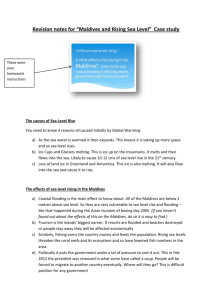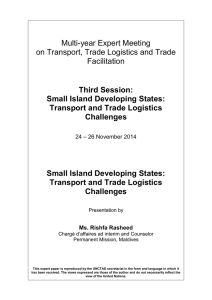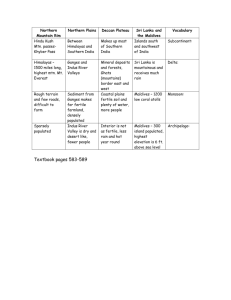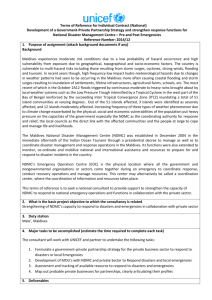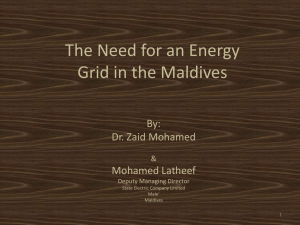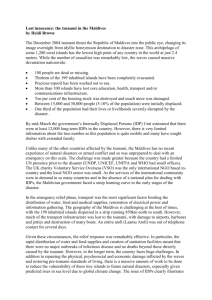THIRD UNITED NATIONS CONFERENCE ON THE LEAST DEVELOPED COUNTRIES Country presentation
advertisement
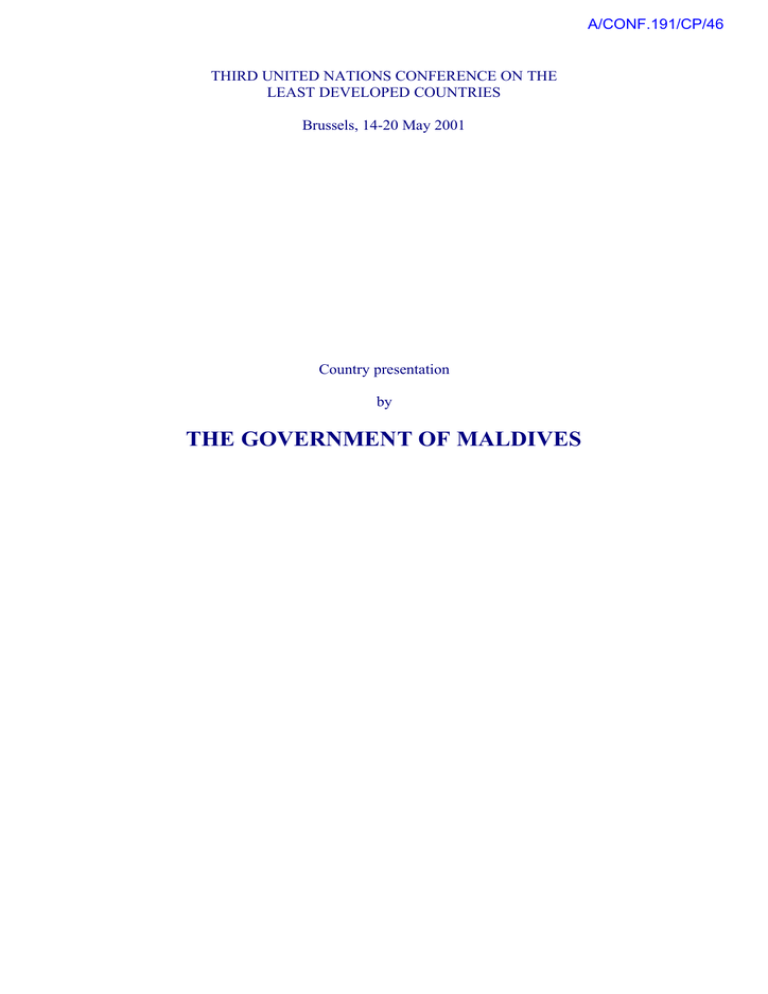
A/CONF.191/CP/46 THIRD UNITED NATIONS CONFERENCE ON THE LEAST DEVELOPED COUNTRIES Brussels, 14-20 May 2001 Country presentation by THE GOVERNMENT OF MALDIVES NOTE The views expressed in this document are those of the Government concerned. The document is reproduced in the form and language in which it has been received. The designations employed and the presentation of the material do not imply expression of any opinion whatsoever on the part of the Secretariat of the United Nations concerning the legal status of any country, territory, city or area, or its authorities, or concerning the delimitation of its frontiers or boundaries. A/CONF.191/CP/46 THIRD UNITED NATIONS CONFERENCE ON THE LEAST DEVELOPED COUNTRIES Brussels, Belgium, 14 - 20 May 2001 Presentation of the Republic of Maldives ACTION PROGRAMME FOR THE DEVELOPMENT OF MALDIVES 2001 - 2010 i CONTENTS Chapter Page I INTRODUCTION…………..…………………………………………… 1 II PERFORMANCE IN THE 1990s…….……………….………………… 2 A. Factors that Facilitated Development in the 1990s ….………….. 2 (a) Tourism sector ……………………………….………….. 2 (b) Macroeconomic management …………………………… 3 (c) Aid ……………………………………………………….. 3 (d) Peace and stability ……………………………………….. 3 B. Development Constraints and challenges…………………………….. 3 (a) Lack of land-based resources ………………………………… 4 (b) Population dispersal ………………………………………….. 4 (c) Open economy …………………………………………..…… 4 (d) Limited internal markets ………………………………..…… 5 (e) Problems of providing basic infrastructure …………………. 5 (f) Isolation ……………………………………………………… 5 (g) Vulnerabilities to natural calamities ………………………… 6 (h) Shortage of qualified manpower ……………………………. 6 (i) Limited access to capital ……………………………………… 6 C. Development Challenges ……………………………………… 7 (a) Eradication of poverty …………………………………… 7 (b) Population and employment …………………………….. 7 (c) Health and nutrition ……………………………………… 8 (d) Education and human resources development …………… 8 (e) Economic diversification ………………………………… 9 (f) Reducing regional disparities …………………………… 9 (g) Shelter and housing ……………………………………… 10 (h) Gender equality ………………………………………… 10 (i) Environment …………………………………………….. 10 III. PROGRAMME OF ACTION FOR 2001-2010 ……………………… 12 1. Education …………………………………………………….… 12 2. Health …………………………………………………………… 13 3. Population consolidation ………………………………………… 14 4. Good governance …………….…………………………………. 15 5. Human resources development………………………………….. 16 6. Poverty eradication through regional development …………….. 16 7. Industry ………………………………………………………….. 17 8. Trade …………………………………………………………….. 18 9. Foreign direct investment ………………………………………. 18 10. Private sector ……………………………………………………. 19 11. Tourism and other services ……………………………………… 19 12. Fishery …………………………………………………………… 20 13. Agriculture ……………………………………………………… 21 14. Physical infrastructure and land………………………………… 21 15. Technology …………………………..…………………………… 22 16. Environment ……………………………………………………… 22 17. Finance and taxation ………………..……………………………. 23 Resource Requirements ………………………………………………….. 25 ii I. INTRODUCTION The Maldives is not only a least developed country but also a small island state with inherent vulnerabilities and associated difficulties. It is a nation-state of 1,192 islands with a population of about 270,000 people, located in the Indian Ocean, from its two nearest neighbours, India and Sri Lanka by about 600 km and 750 km respectively. Although it covers a total area of 100,000 sq. km, the total land area it possesses amounts to about 300 sq. km. The country’s economy – operating on a very narrow economic base – is primarily propelled by tourism and fishing. In 1998, fishing accounted for 9.6 percent of GDP while tourism accounted for 33.8 percent of GDP. In that respect there is a very heavy dependence on tourism for economic growth. Revenues from import duties further support development activities of the country. More importantly, the instrumental role played by its development partners – both bilateral and multilateral – is indispensable. Well-directed assistance towards the implementation of human resources development projects, basic infrastructure projects and other projects supporting socio-economic development activities has been one of the driving forces of the sustainable development achieved in the past decade. This external assistance accounted for 9.9 percent of GNP between 1996-1998. 1 II. PERFORMANCE IN THE 1990s The 1990s saw a period of socio-economic development, which brought considerable prosperity to the people of Maldives, while reinforcing and cementing the achievements gained in the preceding decade. In terms of GDP growth, Maldives recorded an average of 6.5 percent during 1993-1998, as against an average of 9.9 per annum between 19851990. Real GDP per capita grew at the rate of 3.8 per cent per annum from 1990 to 1998. Tourism sector has been the engine of growth of the economy during the last decade, earning much needed foreign currency. The sector accounted for 34.5 percent of GDP during 1995-1998, with a growth rate of 7.8 percent during the same period. In comparison the Fishery sector, which is the other mainstay of the economy registered a sluggish growth rate of 3.8 percent during 1995-1998 while accounting for 7.2 percent of GDP during that period. The manufacturing sector dominated by electricity and water accounted for 2.4 percent of GDP, registering a growth rate of 26.5 percent during that period. The good economic performance masks the real situation out in the atolls, where poverty and lack of basic infrastructure are in evidence. These will be discussed elsewhere in this report. The developments gained in the economic arena have been accompanied by improvements in the health and education sector. Principal social indicators such as life expectancy at birth, infant mortality rate and maternal mortality rate show significant progress. Adult literacy rate and primary school enrolment ratio indicate a substantial achievement. However, the real situation in the atolls, although vastly improved over the past two decade, is worse than the situation in Male’ due to existing disparities between Male’ and the atolls, which would be discussed in the section devoted to constraints and development challenges. A. Factors that Facilitated Development in the 1990s (a) Tourism sector The good performance of the tourism sector was largely responsible for the growth of the economy. Tourism tax accounted for 29 per cent of the tax revenues in 1996. Furthermore, import duty revenues also include duties paid by the tourism sector, given the fact that tourist sector imports constitute a large part of the total imports. In addition, ground rents received by the government from tourist resorts account for 30 percent of non-tax revenues. In total direct revenue earnings from the tourism sector account for 30 per cent of public revenues. If it is assumed that 50 per cent of the import duties are tourism related, then the total contribution by the tourism sector accounts for 46 per cent of public revenues. 2 (b) Macroeconomic management The Government demonstrated considerable prudence in macroeconomic management. Gross domestic savings between 1993-96 were 34.8 per cent of GDP, while gross domestic investment was as high as 45.6 per cent during the same period. The good level of revenue mobilization facilitated such a high level of investment. During 1991-97 revenue mobilization was 36.6 percent of GDP, when compared to 28.2 percent during 1981-1990. (c) Aid The development partners – both bilateral and multilateral – played a key role in the socio-economic development of Maldives. Aid not only bridged the resource gap but also accelerated the development process. The country received assistance towards the implementation of many projects, including those in the area of infrastructure and institutional development, which included the construction of schools, hospitals, health centres, commissioning of harbours and coastal protection and upgrading of airports. Some of the development partners directed their assistance towards human resources development, which involved sending of Maldivians abroad for short and long-term training. The positive impact of aid is highly visible in Maldives. The donors appreciate the efficient utilization of aid in the country. ODA inflows in 1985 amounted to US$ 9 million. This figure increased to US$ 22 million in 1990, and US$ 33 million in 1996. More than 80 percent of total capital expenditure on socioeconomic services and 60 percent of total development expenditure were financed by concessional loans and grant assistance. Foreign aid was equivalent to 17 percent of GDP. These figures demonstrate the magnitude of the country's reliance on external assistance for implementing development projects. The structure of the economy and its narrow economic base necessitate an undesired, yet indispensable dependence on aid. (d) Peace and stability Political and social stability that is enjoyed by the Maldives and the improved governance granted the right environment for advancing development during the last decade. Such ingredients as internal-cohesiveness provided by common history, language, religion and culture, and positive keenness of the people to engage in participatory development were factors which assisted development. B. Development Constraints and Challenges There is no doubt that Maldives has achieved considerable progress over the last twentyfive years. In particular, the last ten years has been noteworthy. Traditional economic and social indicators put Maldives in an elevated position. Maldives is proud of its achievements. Nevertheless, Maldives still remains as a small state with inherent vulnerabilities and structural constraints, which continue to put insurmountable obstacles in the development path. The Commonwealth Vulnerability Index ranks Maldives as the 3 9th most vulnerable country. It is against this reality that Maldives must consider its development options and strategies in the 21st century. In addition, the forces of globalization pose further challenges that may weaken the Maldives further, if they are not addressed adequately. These challenges and constraints must be defined, analyzed and understood in order to device appropriate responses to overcome or lessen their negative impact on the society of Maldives. (a) Lack of land-based resources Small land area means the potential to possess land-based raw materials and natural resources are limited. In fact there are hardly any land-based natural resources. In addition, such basic resources as water and fertile soil are in short supply. Rivers, lakes or even streams are non-existent. Fresh water supply source has traditionally been the fresh water layer, which lies beneath the ground. Nevertheless, population pressure, construction and other development needs have almost depleted the limited lens of fresh water in some islands, while others have been completely exhausted. Male’ the capital of Maldives is an example of total depletion of ground water, as a result of which desalinated water has now become the main source of water for the population of Male'. In addition, contamination of ground water is common, making it unsafe for drinking and cooking purposes. Water is a scarce commodity now in some parts of the country, which further complicates the development process and activities. Lack of fertile soil and more importantly the small land area suitable for agriculture impede the development of the agriculture. Maldivian soils are porous and highly alkaline. Land suitable for agriculture is less than 30 sq. km in the whole of Maldives. Limited land-based resources have its negative impact on the building industry. Traditionally, coral rocks were used as building material for construction of houses. Since coral mining may eventually lead to erosion and undermine the coastal protection of the islands, coral mining is no longer permissible. (b) Population dispersal The population of 270,000 people of Maldives is dispersed over 200 islands, making the population smaller in terms of inhabitants of each island. 76 islands (one-third of all inhabited islands) have a population of less than 500 people; 145 islands (more than 70 % of the islands) have a population of less than 1,000 people. Only 5 islands have more than 3,000 people. Despite the small population, each inhabited island – even islands having population of less than 500 people – must be provided with schools, health care facilities, hygienic water and sanitation facilities, access to electricity and telephone, secure harbour and security from environmental degradation. (c) Open economy The Maldives is vulnerable in terms of export and import of goods and services. Its reliance on the export and import of goods and services leave the Maldives at the mercy of external events beyond its control. Maldives imports virtually everything for its daily 4 needs, such as food items, clothing, housing materials, and medicine. Imports are equivalent to 102 (1997) percent of GDP. Hence any price rise in theses goods contributes negatively to the economy. Similarly, the export sector’s dependency on fishing and tourism industry can disproportionately harm the Maldivian economy during price falls and market fluctuations. This was evident, in early 1990s, when decline in revenues from tuna export was further exacerbated by unfavourable developments internationally which had a negative impact on the Maldivian tourism sector. This double blow caused major macroeconomic imbalances, which necessitated adjustment measures. This process eroded development gains. Similarly in the year 2000, fisheries industry was severely affected by the fall in the price of exported fish. If this was not bad, the increase in the price of fuel put a devastating blow to the industry, as fuel was necessary for fishing boats. These tragic experiences remind the Maldives of its vulnerability. (d) Limited internal markets The Maldives is disadvantaged by the smallness of the domestic market, which impedes the promotion of industrial production for export as well as for local consumption. When the local market is small, it is almost impossible to start a viable manufacturing business such as small-scale light industry. It discourages entrepreneurs from venturing into such business. Further, the inability to benefit from economies of scale further impedes such development. (e) Problems of providing basic infrastructure It is expensive to set up and maintain basic infrastructure such as airports, ports and harbours, electricity, roads, proper sewerage systems and water accessibility. Per capita cost of providing these services is very high. Providing other public services, such as health care, education and administrative services adds to the costs. In short, severe diseconomies of scale occur. For instance a single hospital and few clinics could serve a population of 200,000 people. But for Maldives, this is not adequate, because of the geographic nature of the islands and the distances among them. At least 200 health centres or clinics and close to 10 hospitals are needed to meet the basic health care needs of the people. The impact of these costs on the national budget is severe. (f) Isolation The development efforts of Maldives are affected by its geographic isolation. It creates problems of isolation and remoteness among the islands as well as from other countries. The problem associated with long distance sea transport is a case in point. For instance, although Maldives is a long way away from Singapore, it imports numerous goods from there. However, there is hardly anything that it exports to Singapore (no return cargo). In other words, there is no cargo from Male’ to Singapore, simply because, no cargo is transported to Singapore. Nevertheless, the shipping line has to bear all the expenses required to make the voyage. For the shipping line to make a profit, its freight rates from Singapore to Male’ must take account of the expenses during the empty journey. As a result, freight rates are higher than they would otherwise be, and imported goods are that 5 much dearer. Intra-state shipping fares no better. Bad weather, lack of cargo from the islands to Male’, poor and unreliable transport services make the journeys not only expensive, but also time-consuming and hazardous. Hence development activities in the outer islands are negatively affected. (g) Vulnerabilities to natural calamities The development efforts of the Maldives continue to be affected by natural calamities. The small size of the islands in terms of land area coupled with lack of coastal trees, leave Maldives exposed to high winds. For instance in 1991 Maldives was hit by a severe storm with extremely high winds and heavy rainfall, which devastated many houses and uprooted many trees such as mango, coconut, bread fruit, specially in the outer atolls. Some of these trees take years to grow and people rely on these trees for income. For instance, mango fetches a high price in the local market. It becomes a source of revenue for the island folks. In addition, the low-lying nature of the islands – the islands barely one meter above sea level – leaves them vulnerable to the forces of tidal surges. For example, in 1987 the Maldives was struck by a tidal surge. Male’ suffered most during this surge. Since, then a high proportion of aid received by Maldives is being used to strengthen coastal defence of Male’ in the form of breakwaters, seawall and other preventive measures. The expenditure required for preventive measures exceeded $70 million. These funds would have, otherwise, been used for other development activities. Like Male’ the other islands face the same vulnerabilities. Even at present, up to 90 percent of all inhabited islands suffer from coastal erosion. (h) Shortage of qualified manpower The Maldives’ development activities are continually hampered by the shortage of qualified and skilled manpower. Often, the expertise available is not being used efficiently, due to various constraints. Sometimes, qualified people are under-employed because of lack of investment or they may be obliged to take too many functions. The import of expatriate labor is a direct result of lack of qualified manpower. The expatriate labor force, which includes teachers, accountants, construction workers, doctors, nurses and laborers, has now risen up to more than 27,000. This large size of the expatriate sector creates economic problems such as foreign exchange transfers. Last year, the expatriates repatriated about US$ 45 million. The social consequences of this challenge are enormous. (i) Limited access to capital One of the most important factors, which inhibit the development process of the Maldives, is the limited access to capital, namely, soft-term loans and grant aid, and private capital investment. For private investors, Maldives does not seem to be attractive as it is not in a position to offer many inducements to prospective investors. Even when such investments are obtained, lack of bargaining power, lack of negotiation skills and lack of access to relevant information prevents its ability to secure the most beneficial outcomes. As a result no breakthroughs have been achieved in the area of FDI. 6 C. Development Challenges (a) Eradication of poverty Although the country's current GDP per capita figure shows considerable improvement for the last two decades, a scrutiny of the country's income distribution reveals that significant disparities exist. One in four earn less than the World Bank's poverty line of US$1 per day, 43% earn less than US$1.25 each per day, and the average income of 75% of the population is US$1.60 each per day. The country ranks the 7th worst in the world in terms of malnutrition. The situation needs to be changed and active measures have to be taken to improve the lives of those affected. (b) Population and employment Against the backdrop of scarce resources, the population growth rate must be considered as a challenge to sustainable development. At the end of 1980s population growth rate was 3.4 percent per annum. Although, the rate fell to 2.7 in 1995, Maldives still had the highest population growth rate in South Asia. The average for the developing country was 2.2 percent; while the average for all least developed country was 2.5 percent. The current age structure of the population suggests that the population growth rate may increase. Almost half of the population is under 15 years. When this youth population begins to reach adulthood, and starts family life, the likely result may be a growth rate increase. Unsustainable level of population growth would seriously challenge the development activities in terms of food security, employment opportunities, housing, and the costs of providing and maintaining social infrastructure, including schools and health care facilities. Of these, employment opportunities warrant further examination. The very high percentage of youth population means that by the year 2005, more than 26,000 young people would have entered the labor market. Even if a number of them opt to join various study programmes, those actively seeking jobs would be at the rate of about 5000 per year. The serious question is whether or not Maldives can create 5000 jobs every year. The hard reality is that this number far exceeds the number of jobs currently available in the country. The nature and the level of the socio-economic development of Maldives would not be able to cope with this increasing demand for jobs. Thus in many respects, the creation of employment opportunities for the upcoming youth would be one of the most critical development challenges in the decade 20002010. Naturally this must be a high priority for the first decade of the new century. 7 (c) Health and nutrition The achievements in the health sector can only be sustained by addressing the current challenges faced by the health sector. There is an urgent need to improve access to and the quality of basic health services. Of the 200 inhabited islands in the country, some do not have adequate levels of health care, while some are far away from atoll-based health infrastructure. Some of the existing atoll-based health centres need to be modernized and upgraded. Policy implementation will have to take into account the high cost of providing heath care facilities to the population in the face of many other obstacles including the lack of qualified doctors, nurses, community health workers as well as transport and logistical difficulties. The challenge of providing access to safe drinking water and proper sanitation for the whole population dispersed over 200 islands is no small task either. The good old day reliance on ground water supplies is no longer safe. Many islands have run out of ground water. The little they have now is either saline or contaminated. The feasible option of rainwater collection schemes being implemented cannot meet the demand of the population for a healthy life, as the current provision amounts to only 2 litters of potable water per person per day. There is high incidence of worm infestation, linked to poor access to potable water and hygienic sanitation. Careful analysis of the morbidity profile of the country reveals that further preventive action is needed in this area in addition to the curative measures. The threat of HIV/AIDS is a real cause for concern in this closely knitted society. While most contagious diseases have been brought under control, non-communicable diseases are becoming increasingly serious in terms of public health. These include, thalassaemia, a congenital blood disorder in which Maldives has one of the highest incidences in the world, heart diseases, diabetes, renal diseases and other ‘life style’ diseases. Therefore, continuing efforts to expand access to basic health care and to maintain control over contagious diseases must go hand in hand with the implementation of new initiatives that respond to changes in the patterns of diseases. While there is no chronic hunger in the Maldives, some forms of malnutrition do exist, particularly among women and children. This is mainly caused by the absence of a balanced diet. The preferred diet in many of the households does not include fruit and vegetables as a result of which the required doses of vitamin and minerals are not found in the diet. The UNDP’s own study reveals that the Maldives is the 7th most malnourished country in the world. It has also been estimated recently that close to onehalf of children in Maldives suffer, to varying degrees, from stunting and wasting. A recent study estimated that more than 60 per cent of pregnant women suffered from anaemia, while another study of one atoll estimated that 8 percent of pregnant women were below the cut-off points set by WHO for mean haemoglobin levels. These are pressing challenges, which need to be overcome. (d) Education and human resources development Although the country enjoys the 98 percent adult literacy rate, largely the result of the Main Education Programme launched in 1981, it must be noted that literacy qualification 8 includes only reading and writing and not comprehension unlike in the definition that is normally used in assessing literacy. In addition, gross school enrolment ratio is bloated by the fact that both under-aged and over-aged children remain enrolled in schools. While considerable progress has been made in the education sector, tremendous work needs to be done to overcome the quantitative and qualitative problems. Some island primary schools are without trained teachers, and national curriculum, teaching materials and texts have not found their way to these schools. These shortcomings result in poor quality education in these schools. Furthermore, many of these schools do not have basic facilities such as water and sanitation. Although primary school enrolment is high, not all pupils complete primary school. It must also be noted that Secondary education enrolment is still only one-half of the relevant age group, mainly due to the absence of secondary schools in all the atolls. The challenge is to build more secondary schools in the atolls in order to meet the growing demand for secondary education. Admittedly, one of the biggest challenges in the education sector is to meet the demand for tertiary education, including degree programmes, various diploma programmes and technical education programmes. As Maldives moves ahead with development, the challenge is to produce skilled people in terms of knowledge, experience and general attitude to fill those jobs created by development as well as to fill those jobs that are now filled by expatriates. The lack of experience in the management of tertiary level of education and the lack of qualified lecturers and instructors and mangers and the lack of financial resources do impede the development of this sector. (e) Economic diversification The narrowness of the nation’s economy makes the Maldives highly vulnerable to external shocks beyond its control, which can seriously damage the economy to the point of stagnation and under-development. It limits the employment generating capacity and revenue generating capacity of the economy. Long-term sustainable development will not be secure with over-reliance on tourism and fishing sector. In recent years fishing sector has been experiencing the negative effects of price fluctuations, which has upset the economy in terms of declining foreign currency earnings and falling revenues. This has brought home the devastating consequences of external shocks. As the narrow economic base stems from its smallness and associated structural constraints, such as small domestic market, lack of resources such as financial, material and skilled human resources as well as isolation from major markets, the challenge is to make concerted efforts to diversify the economy by addressing these problems. (f) Reducing regional disparities There are significant differences and disparities between Male’ and the atolls which are not shown by conventional economic and social indicators. For instance, in education and health care, considerable disparities do exist in terms of quality, quantity and accessibility. The great opportunity available in Male’ for employment is a significant difference as well. These differences increase atoll-Male’ migration and adds to the 9 overcrowding in Male’. In addition, disparities also exist between islands and between atolls in socio-economic areas. These disparities must be reduced through sustainable growth and balanced development. (g) Shelter and housing The basic need of housing and shelter is one of the main challenges faced by the Maldives today. The growing population and the large numbers of young people reaching adulthood would result in a great demand for housing. While Maldivians do take pride in the absence of homelessness in Maldives, Maldives does not have the luxury of vast land to meet the housing demand of each and everyone. Yet this demand for housing – one of the most basic needs – must be met somehow. Nevertheless, the uneven distribution of population and the scattered nature of the islands with small land areas do not make it easier to find a solution. The lack of comprehensive action in this area in association with other factors contributes to overcrowding. Overcrowding is most severe in Male’, where nearly 70,000 people live on an area of less than 2 sq km. This is a density of about 35,000 persons per sq. km – one of the highest anywhere in the world. Such overcrowding leads to overflow of people in dwellings, unhygienic conditions in houses, spread of contagious diseases, lack of privacy, break of marriages, and increasing emotional problems. Overcrowding is fertile ground for social problems, such as drug abuse, crime, child abuse and juvenile delinquency. Responsible and innovative policy actions must be taken to overcome the problem of housing and shelter in a manner consistent with the immediate and long-term objectives of the country. (h) Gender equality Although Maldivian women are among the most emancipated in the Islamic world, reflected in positive rankings in the Gender-related Development Index (GDI), and the Gender Empowerment Measure (GEM), gender issues need attention and action. While women continue to play an important role in the economic development, men overwhelmingly dominate the private sector. Only a handful of women own business enterprises. This is mainly due to traditional attitudes and the lack of access to capital. Traditional attitudes have also meant that very few women have gone into employment in the tourism sector. For example, it in 1996 while 5,000 Maldivians was employed by the tourism sector, less than 100 were women. Therefore the challenge is to facilitate and motivate the entry of women into the private sector and especially encourage them to take up employment in the tourism sector. (i) Environment The Government and the people of the Maldives are aware of the need to protect the environment. They are aware of the global warming and climate change and resulting sea-level rise, which may threaten the very existence of the Maldives. They know that the country’s rapid economic and social development and the habits and needs of the 10 population exert considerable pressure on the fragile resource base causing environmental problems. These problems and challenges include, sewage disposal; solid waste disposal; depletion and pollution of water supplies in the more populated islands; unsustainable exploitation of some marine species; destruction of coral reefs and reef habitats; coastal erosion; environmental and occupational health problems; and climate change. Actions taken to protect the environment include, banning coral mining from house reefs; introducing incentives to promote the use of other construction materials; designation of numerous locations as ‘ marine protected area’ so as to conserve reef and surrounding marine systems. Despite these actions, and mitigation strategies at national level, the survival of the lowlying Maldives largely depends upon the world community and the decisions it takes to combat global warming. Recent failures to conclude and implement global strategies that would have been able to reverse negative environmental trends do not augur well for the future. 11 III. PROGRAMME OF ACTION FOR 2001-2010 The Programme of Action (POA) aims to achieve sustained improvements in human conditions. Socio-economic development programmes will be implemented to improve the quality of life throughout the Maldives. Such improvements must encompass advances in both material and nonmaterial status, more income with reduced disparities, better housing, improved access to quality health and education services, environment resilience, diverse opportunities for employment and recreation. The POA has been drawn up in line with the Vision 2020 announced by the President of Maldives, and the 6th (5-year) National Development Plan (NDP). The POA is therefore one of the main planning documents that would guide development process towards the attainment of Vision 2020. When this POA ends in the year 2010, it will mark the halfway of the Vision time frame. The following include the high-priority areas, which need the combined efforts of Maldives and donor community to sustain the development through to 2010 and beyond. 1. Education While considerable progress has been made in the education sector, tremendous work needs to be done to overcome the quantitative and qualitative shortcomings in education. At the same time there is the need to meet the growing demand for primary, secondary and tertiary education. The following actions should be taken to achieve the desired results. 1.1 Improving the quality of preschool, primary and secondary education; 1.2 Expanding and diversifying secondary education; 1.3 Developing local capacity for teacher education; 1.4 Improving adult and continuing education; 1.5 Strengthening educational management; 1.6 Establishing internationally recognized higher education and training by strengthening and expanding the institutional and human resources capacity of the existing tertiary education system; 1.7 Providing all schools with necessary equipment and facilities; 1.8 Conducting a 5-year national program to train at least 500 teachers to reduce reliance on expatriate teachers, to meet the needs of increasing enrolment, and to improve teacher/student ratio; 1.9 Establishing a national student achievement monitoring mechanism; 12 1.10 Strengthening the supervision and management capacity of school clusters; 1.11 Revisiting the national curricula to include among other things values education, and making computer literacy a component of basic education curriculum and ensure that at least one computer is available for every 20 to 30 students in each school; 1.12 Completing a needs assessment of special needs students, and providing inservice training for teachers to mainstream special needs students where possible; 1.13 Developing a national educational management information system; 1.14 Ensuring equitable access to basic and continuing education for all adults; 1.15 Designing the delivery of adult education and continuing education opportunities based on learner needs, employment market needs, and projected skill requirements; 1.16 Ensuring that young peoples learning needs are met through equitable access to appropriate learning and life skill programs; 1.17 Providing necessary infrastructure to raise net enrolment ratio (NER) in secondary schooling from 36 to 80 within the next ten years, for which it is estimated that 800 additional classrooms and a thousand secondary teachers would be needed over the next ten years; 1.18 Providing a “diversified” secondary curriculum that is student-centred, culturally relevant, and one that provides diverse learning opportunities, particularly for less academically inclined students; 1.19 Encouraging private sector to offer college-level training programs to meet the learning needs of the young people. 2. Health The achievements in the health sector can only be sustained by addressing the current challenges faced by the sector. There is an urgent need to improve access to and the quality of health care facilities. The following actions should be taken to bring good results in this regard. 2.1 Improving the nutrition status of the population with special emphasis on maternal child nutrition, and malnourishment; 2.2 Continuing immunization and improving vaccination; 2.3 Maintaining the efforts to control communicable diseases and reducing the incidence of vector borne diseases; 2.4 Addressing the issue of growing mental health problems; 13 2.5 Promoting healthy environment concepts; 2.6 Strengthening food safety and hygiene programme; 2.7 Implementing occupational health and safety standards, and other public health standards; 2.8 Developing adolescent support programmes; 2.9 Addressing the issues of growing elderly population and establishing mechanisms to support their well-being; 2.10 Fostering and improving complementary medicine; 2.11 Providing affordable diagnostic and curative services; 2.12 Strengthening information, education and communication programmes based on health promotion to foster healthy lifestyles; 2.13 Developing national capacity of the health sector by developing human resources for health; 2.14 Providing appropriate infrastructure for health care delivery; 2.15 Fostering evidence-based change by developing and using a proper management information system; 2.16 Broadening the coverage of available pharmaceuticals and drugs; 2.17 Improving the quality and standards of health care delivery at all service levels; 2.18 Enhancing private sector and NGO participation in health services; 2.19 Improving the regulatory and legislative framework for the health sector; 2.20 Developing a comprehensive social security package; 2.21 Upgrading the existing regional hospitals in terms of medical equipment, laboratory services, doctors and nurses; 2.22 Upgrading the existing health centers and health posts in the atolls in order to meet the current medical demands of the population. 3. Population consolidation There are too many islands with either little population or with limited land area - nine islands with land area of 100 hectares, 130 smaller than 50 hectares, 145 with fewer than 1000 people, about 76 islands having less 500 people. For each island, big or small, basic infrastructure and socio-economic services, in addition to other, will have to be provided, 14 which eats up scarce resources. Therefore relocating people from smaller and nonproductive islands to larger and better serviced islands is essential to reduce the number of inhabited islands so that the benefits of economies of scale can be achieved. Actions to address the problems resulting from the fragmented nature of the population will be along the following lines. 3.1 Providing housing and physical infrastructure to selected islands, which will host population from other smaller islands; 3.2 Establishing an efficient and effective network of social services on the islands; 3.3 Creating an environment which will facilitate the growth of household incomes and increase opportunities for productive employment; 3.4 Construction of houses, basic road network, water and electricity supplies health centres; 3.5 Construction of jetties and improvement and commissioning of harbours; 3.6 Provision of appropriate coastal protection measures. 4. Good governance In order to further consolidate the development achieved socially and economically, it is important to appropriately shape and strengthen democratic governance, consolidating the peace and stability enjoyed by the people, which is one of the prime movers assisting development. Actions to strengthen the country's governance will be guided by the following. 4.1 Strengthening further the democratic system and democratic norms and conventions upon which the powers of the state are based; 4.2 Continuing to promote good governance, accountability, respect for the rule of law, efficiency and ethical standards in public service, and greater transparency in the decision making process; 4.3 Facilitating and enhancing the opportunity available for the freedom of expression; 4.4 Continuing to ensure equality before the law; 4.5 Continuing to take vigorous measures, including the effective application of anticorruption laws, to fight and eradicate corruption; 4.6 Continuing to consolidate fair and effective institutional, legal and regulatory framework with a view to strengthening the rule of law; 4.7 Continuing to protect and promote gender equality, non-discrimination and the empowerment of women in the socio-economic development of the country. 15 5. Human resources development One of the ingredients for sustainable development is an able and competent workforce in all areas of development activities. There is a huge gulf between the locally available qualified manpower and the requirement of the country. In order to maintain the speed of development, there is continuous inflow of expatriates to fill this gap. Therefore, priority must be given to human resources development with a view to making available a pool of trained Maldivians to take up skilled jobs, thereby minimizing the overdependence on expatriates. The following actions should be taken to achieve these goals. 5.1 Developing human resources to support development requirements; 5.2 Reviewing national human resources development policies to determine areas to strengthen; 5.3 Determining the long-term national labour requirements; 5.4 Reviewing national skill profiles to identify areas to upgrade; 5.6 Enacting comprehensive employment laws, which among others, addresses the issues of worker and employer rights, etc.; 5.7 Establishing an all-inclusive information system that would facilitate policy makers, workers, employers as well as job-seekers; 5.8 Strengthening and increasing institutional and human resources capacity to continue training the required workforce for the economy; 5.9 Encouraging the role of the private sector in human resources development. 6. Eradication of poverty through regional development The fruits of the economic development of the past two decades have not been evenly distributed. The capital, Male' (accommodating about 25% of the population) being the main hub of the economic and social activities, has developed faster than any part of the country, resulting in significant disparities between Male’ and the rest of the country. These disparities in turn lead to poor income in the atolls. For example, one in four earns less than the World Bank's poverty line of US$1 per day, 43% earn less than US$1.25 each per day, and the average income of 75% of the population is US$1.60 per day. Therefore, in order to reverse this trend and redress these imbalances, priority is accorded to regional development and decentralization, with the ultimate aim of eradicating poverty in the atolls. The following actions will help achieve these objectives. 6.1 Continuing to develop regional growth centres to ensure a more equitable distribution of the necessary public and social infrastructure to support private investment initiatives, and to bridge the growth and progress gap between the atolls and Male'; 16 6.2 Ensuring equitable access to social services throughout the country which includes income distribution and the distribution of, and public access to, social infrastructure and services; 6.3 Developing the physical infrastructure for water supply, sanitation, solid waste and roads; 6.4 Establishing an institutional capacity for land and water use planning, for environmental management and for the coordination of development activities in the regions; 6.5 Providing income generating initiatives, for example, in the areas of fisheries and associated industries, tourism, agriculture and recycling initiatives. 7. Industry The economy's over-reliance on tourism and fishery is showing signs of the economic shocks that Maldives faces. In order to reduce such risks and minimize their impact on the economy, the country needs to look into ways of diversifying the production of its goods and services. The following is intended as a guideline for action in this regard. 7.1 Preparing a 10-year industrial master plan to increase and diversify production, particularly for export; 7.2 Assessing the prevalent situation to identify whether existing industries (e.g. garment industry and fishing) are threatened by globalization and to determine whether (and what) actions are needed to counter the problems and how; 7.3 Identifying the feasibility of enhancing existing and developing new industries to cater to domestic markets, and enhancing competitiveness of local production, re-organizing and modernizing the traditional handicraft industries, (e.g. mat weaving and lacquer working, etc.,) to cater to the growing tourist market; 7.4 Developing industrial and export processing zones, and providing the required infrastructure to support the sustainable development of the desired industries; 7.5 Determining and building the required human resource capacity to support the sustainable development of industries, and identifying the other requirements of the plan, including acquiring/transfer of technology, mobilizing finance, marketing, technical assistance in these and other relevant fields, etc.; 7.6 Making the policy environment more conducive for long-term investment through measures, (e.g. increasing predictability and enhancing transparency) to build lasting investor-confidence; 7.7 Strengthening the commercial law by enacting legislations such as on intellectual property, e-commerce, etc.; 17 7.8 Making recommendations as to how more processed, new fish (and possibly other marine-based) products as well as non-marine products could be developed and marketed as 'exotics' to markets willing to buy them at attractive prices; 7.9 Establishing a comprehensive information collection and dissemination system, making use of among others, information technology, to monitor developments in the overall industrial sector, and within specific industries to enhance the policy making process; 7.10 Developing a wide ranging programme to assist small businesses to provide them services such as training on managing, accounting, marketing, etc.; 7.11 Establishing a trans-shipment port to cater to shipping lines operating between the west and the east. 8. Trade Trade, in both goods and services, dominates international relations today. To sustain the economic growth the Maldives has been able to achieve so far, trade needs to be expanded to turn terms of trade in its favour and to increase the inflow of foreign currency that is so badly needed for such a net importing country. Actions intended in this sector will be along the following lines. 8.1 Mainstreaming trade to make it a more dependable instrument of development, like the tourism industry, and to gear the country's production towards export of goods and services; 8.2 Taking initiatives at a macro-level to make export products competitive and to improve the quality of the products; 8.3 Working towards availing the benefits of existing preferential trading mechanisms and to enhance such benefits, and taking a more proactive role in establishing and enhancing bilateral and multilateral trading relations for improving market access to export products; 8.4 Working towards building capacities in terms of human resources and institutional strengthening, etc., that are needed for maintaining a conducive trading environment and to acquire expertise in research, provision of technical support for the trading community, development of local technology, etc.; 8.5 Availing the opportunities arising from the Integrated Framework for Traderelated Technical Assistance; 8.6 Establishing sustainable large-scale re-export trade. 9. Foreign direct investment The smallness of the domestic market acts as an apparent disincentive for investors. When preferential treatment is available to Maldives in its export markets, investors deem 18 it a factor positively influencing their decisions to invest in the country. In increasing foreign direct investment (FDI), the following indicate the path on which the country intends to take action. 9.1 Sensitizing stakeholders about the importance of foreign direct investment for accelerating growth and income distribution; 9.2 Enhancing the performance of the government's foreign investment promotion agency by providing more resources for the purpose, relieving it of conflicting duties, as well as by strengthening the human resource capacity. 10. Private sector Applying simple comparative advantage logic, governments have increasingly recognized that privatization increases efficiency and accelerates growth. A number of state-owned enterprises (SOEs) are already joint-venture company with either local or foreign private sector companies. The government refrains from too much involvement in management of these companies, and this trend of gradual privatization of the SOEs need to be continued. Furthermore, areas for commercial operation and investment by the private sector need to be offered to strengthen the role of the private sector in the socioeconomic development of the society. Actions to achieve these broad objectives will be taken along the following lines. 10.1 Providing a conducive soft infrastructure for enhancing the development role of the private sector by a sound policy environment and an institutional support mechanism in financial and non-financial resources; 10.2 Launching a long-term privatization programme to allow private commercial organizations, be it foreign or local, to hold a stake in the enterprises currently owned or managed by the government. 11. Tourism and other services The development of tourism in the Maldives represents a textbook example of the success of development of industries by the private sector. This success, however, does not leave any room for complacency in the industry, for high prices and severe competition threaten to falter development. In addition to taking measures to capitalize on the achievements of the tourism sector, possibilities need to be explored for developing other exportable service products. The following provide the direction along which actions need to be taken. 11.1 Developing support services, physical and soft infrastructure and human resources to manage the sustainable development of tourism; 11.2 Consolidating and diversifying the tourism product, such as recreational fishing, safari tourism, etc., to cater to more market segments; 11.3 Exploring hitherto untapped markets to ensure high occupancy rates throughout the year; 19 11.4 Developing sound policies and mechanisms to retain a larger chunk of tourism proceeds within the country; 11.5 Optimising the contribution made by the tourism sector towards national income, employment growth and the balance of payments, by creating favourable economic environment and regional development initiatives; 11.6 Exploring the possibility of developing other service industries in the areas of financial services, information communication technology (ICT), electronic commerce, bunkering and port services, etc. 12. Fishery Fishing has been the main industry of the economy after tourism. However, it has experienced a sluggish performance in recent years. It is therefore of paramount importance to re-orient, re-energize and modernize the fishing industry in order to attract the upcoming youth to the industry and to maximize export revenues. The following actions should be taken to achieve these objectives. 12.1 Initiating a long-term fishery master plan to explore diversification of the industry, which will include among others, product development and quality control, to enable optimal utilization of the country's marine, particularly tuna, resources, taking into account the issue of equity; 12.2 Upgrading the Maldives tuna fishing fleet, with facilities for longer fishing trips, to tap into the country's outer seas and Exclusive Economic Zone; 12.3 Tapping into unutilised reef fishery under better resource management policies and mechanisms to make the development of the industry more environmentally sustainable; 12.4 Extending continued support to socio-economic research activities targeted to specific development programmes, through domestic and international collaborative research; 12.5 Introducing mari-culture of some of the locally available species, and possibly other suitable ones; 12.6 Implementing an integrated marine policy to facilitate and catalyse resource management measures on the one hand, and to ensure consistency in policies and strategies that policy makers adopt; 12.7 Protecting areas under threat of being over exploited; 12.8 Establishing sanitary and phytosanitary (SPS) standards; 12.9 Providing for greater private sector participation in the fishing industry. 20 13. Agriculture Agriculture in recent years has shown a steady growth. The growing demand for fruits and vegetables in the domestic economy has prompted traditional farmers to apply new technologies in this sector, which is showing promise for further development. The following actions should be taken to strengthen and diversify the sector. 13.1 Implementing ecologically sustainable agri-business strategies to ensure the attainment of maximum economic and social benefits from the sector while conserving the genetic resources for future generations; 13.2 Facilitating increased growth and diversification within the agricultural sector through transfer of appropriate technologies; 13.3 Increasing participation of the private sector in agricultural production, product diversification and in-country value addition, in order to fully ensure economic benefits through expanding primary production; 13.4 Developing local human resources capabilities and expertise to support agricultural development; 13.5 Improving the legal and public sector efficiency for the implementation of agriculture reform; 13.6 Availing the existing support services on offer at donor countries as well as international economic co-operation organizations such as the Common Fund for Commodities to develop commodities, which would contribute to improving terms of trade. 14. Physical infrastructure and land Land is extremely scarce in the Maldives, which acts as a severe constraint on the development of the country. The present land allocation policy of assigning a plot of land for each eligible individual, which in turn creates numerous social and environmental problems, not to mention the disincentives to invest, therefore needs to be reviewed. Such a review must reduce the burden of the excessive costs of establishing the basic infrastructure on the islands. These objectives will be pursued by taking measures along the following lines. 14.1 Reforming the land use policy to encourage the establishment of a robust real estate business sector; 14.2 Providing resources to support real estate business, which among others should include housing finance; 14.3 Enacting a comprehensive construction and housing code; 14.4 Developing land use planning taking into consideration the industrial policies in establishing light and heavy industries in populated areas of the regions; 21 14.5 Improving infrastructure to cater to internal as well as external land, sea and air transportation needs; 14.6 Establishing base load power generation capacity making use of alternative energy sources; 14.7 Developing and adopting physical and social infrastructure and servicing guidelines for residential development; 14.8 Commissioning of harbours and jetties. 15. Technology Modern technology helps to quicken the pace of development. The technological revolution sweeping the globe has brought about enormous achievements in areas such as socio-economic arena. The Maldives must join the digital age to reap these benefits. Extra measures must be taken to equip the Maldives with appropriate technology in order to speed up development activites through better performance with the aid of technology. The following actions should be taken in this regard. 15.1 Making modern technology widely available in all spheres of life, to accelerate development activities and to obtain modern conveniences; 15.2 Building human resource capacity to training of manpower in the area of science and technology; 15.3 Encouraging the use of modern technology in sea transport and shipping; 15.4 Setting up cost-effective information communication and technology infrastructure to establish Maldives as an integral part of the global information infrastructure; 15.5 Establishing Maldives as an integral part of the global information infrastructure and facilitate the wide use of such services as internet on a competitive basis; 15.6 Setting up of a nation-wide high-speed information network; 15.7 Making telephone connections available to all households at reasonable rates; 15.8 Establishing television signal receiving stations in all the atolls to facilitate the use of cable television; 15.9 Encouraging and facilitating the private sector to widen its role in the development of technology culture. 16. Environment Maldives, merely three metres above sea level, is highly vulnerable to the forecast sea level rise and other adverse effects of climate change. Other threats to the environment 22 include, coastal erosion, tidal surges, and severe storms. Against the backdrop of this reality, it is absolutely essential to continue taking further measures to counter these environmental threats in a manner consistent with sustainable development. The following actions should be taken to achieve this objective. 16.1 Continuing to work towards protecting and preserving the fragile environment of the country by introducing measures necessary to doing so and by making the necessary resources available; 16.2 Establishing recycling industries and nation-wide environment-friendly practices to make good use of waste wherever possible; 16.3 Protecting the islands from natural disasters, coastal erosion; 16.4 Establishing a nation-wide system for solid waste management and disposal; 16.5 Relocating people from smaller islands to larger islands; 16.6 Regulating the mining of coral, sand and aggregate building and construction industry; 16.7 Establishing environment-friendly solid waste disposal system on each island; 16.8 Promoting production and use of recycled material; 16.9 Launching a public awareness campaign to publicise the damage caused to the reef by the dumping of rubbish into the lagoon/sea; 16.10 Strengthening the institutional and human resource capacity in order to do research, monitor and analyse environmental implications of human activities and natural phenomena, with a view to devising and implementing sustainable policy measures; 16.11 Establishing sound policies to ensure that the country's natural resources, fish and other marine-based species, are exploited in a balanced manner, with due regard to environment and the interests of the stakeholders; 16.12 Monitoring and assessing the effects of international developments on the country's natural resources through participation in relevant bodies. 17. Finance and taxation Lack of financial resources is one of the major drawbacks the country is faced with in its development endeavours. While the country as a whole depends to a quite significant extent on the international donor community to provide concessional finance and grants for implementing development projects, entrepreneurs have only access to commercial finance with tough terms. Moreover, the government heavily relies on import duty as one of its main revenue sources. This situation needs improvement, and the following is intended to provide a direction to take action in this regard. 23 17.1 Establishing a financing mechanism to alleviate the problems arising from the absence of investment financing facilities; 17.2 Establishing a tax system to reduce the over-reliance on import duty for government revenue and to reduce its inflationary effects, particularly on production costs; 17.3 Establishing an appropriate financial market with instruments to facilitate portfolio investment, saving as well as to use it as a supporting source for venture finance; 17.4 Developing institutional and human resource capacities to introduce and maintain a conducive environment to foster a sound financial sector; 17.5 Developing a Mutual Fund Scheme, to assist in the wider distribution of resource use benefits and wider participation of the decentralized island-based communities. 24 Resource Requirements The POA will be used to guide and direct the development of Maldives halfway into the implementation of Vision 2020 strategies. It is estimated that about US$700 million will be required in this decade to implement the actions, programmes and various development projects in line with the POA. However, the gap between the available domestic resources and the funds required is considerable, in spite of the best efforts to increase the resource mobilization domestically. In the past more than 80% of the total capital expenditure in socio-economic services came in the form of concessional loans and grant aid from the international donor community. Therefore, Maldives still requires at least the said level of active participation of the international community in its development efforts in the form of grant aid and concessional loans, and technical assistance, in addition to preferential access to the markets of the developed countries. Failure to secure this amount of ODA would upset the development pace to the extent of creating negative economic growth, high unemployment, and worsening the level and extent of poverty. The country has a good track record of utilizing aid money to produce and achieve developmental results as desired by both the Maldives and the international community. The donors can take comfort from these positive outcomes. The continuation of good aid policies towards Maldives by the donors will help achieve sustainable development in this decade as outlined in the POA. 25

